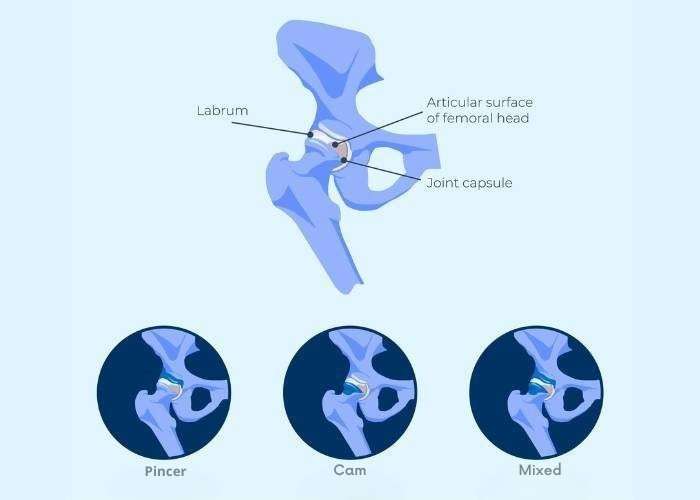FAI and Hip Labrum Tear Specialist
Femoroacetabular impingement (FAI), or hip labrum tears can cause pain and difficulty in sports or even day to day living. Pain in the groin area and outer thigh can be an indication of hip impingement or a labral tear. Selecting a specialist with experience in treating Femoroacetabular Impingement (FAI) is crucial to a positive outcome. Doctor Prem Ramkumar, labral tear and hip impingement specialist, is located in Long Beach and serves patients in Los Angeles, Orange County, and surrounding Southern California areas. Contact Dr. Ramkumar’s office today!

What is femoroacetabular impingement (FAI)?
The femur (thigh bone) and the pelvis (hip bone) are the two bones that make up the hip joint. Often referred to as a ball and socket, the ball-shaped surface of the femoral head fits into a cup-like depression of the pelvic bone. Smooth cartilage connects the bones, stabilizing the joint and making it easy to move. Femoroacetabular impingement (FAI) occurs when extra bone develops around the femoral head and/or along the acetabulum. This abnormal bone prevents the hip joint from moving smoothly, causing the labrum to tear, the articular cartilage to break down, and resulting in stiffness and discomfort for the patient. This abnormal bone arises from open growth plates that are present in adolescence and young adulthood and are triggered from overactivity, particularly ones involving squatting, lunging, and repetitive hip flexion. When untreated, this hip impingement leads to early arthritis. By addressing hip impingement early, there is a high likelihood of improving range of motion, pain, and even potentially lowering the risk of of arthritis. Dr. Prem Ramkumar, FAI specialist, is located in Long Beach and serves patients in Los Angeles, Orange County, and surrounding Southern California areas.

What causes hip impingement?
Femoroacetabular impingement occurs when the free ranging ball-and-socket hip joint becomes a square peg in a round hole, resulting in stiffness. This stiffness results in added stress to adjacent joints – like the lower back, knee, pelvis, and other hip – to do more to make up for the limited hip. Many people with femoroacetabular impingement do not realize they have it as the spectrum of pain and stiffness present variably in the population. As previously mentioned, athletes are more prone to hip impingment, or FAI, given the repetitive hip exercises during the critical period in adolescence and young adulthood when growth plates are open. In particular, soccer, hockey, softball, lacrosse, and track and field are particularly notorious for hip impingement. Early diagnosis and treatment of hip impingement with an experienced hip specialist like Dr. Ramkumar can help you better decide how to manage your symptoms.
What are the different kinds of femoroacetabular impingement (FAI)?
There are three types of femoroacetabular impingement.
- Cam Impingement: A bump forms on the edge of the ball of the femur, leading to excessive grinding against the joint’s cartilage. Because the joint no longer moves freely, it injures the articular cartilage and results in a labrum tear.
- Pincer Impingement: Extra bone forms out over the normal rim of the acetabulum, which can crush the labrum and damage the femoral head.
- Mixed Cam and Pincer Impingement: This means a patient has both types of impingement in the joint. This is the most common type of impingement.
What are the symptoms of femoroacetabular impingement (FAI)?
Symptoms of femoroacetabular impingement include pain with sitting, a limp when walking, stiffness with limited hip range of motion, catching, and clicking. Other symptoms are:
- Pain in the groin and outer thigh area, especially when the hip is flexed and internally rotated.
- Pain that radiates to the outside of the hip and even to the low back or knee.
- Pain that can range from a dull ache to sharp intense stabbing.
How is femoroacetabular impingement (FAI) diagnosed?
Dr. Ramkumar will conduct a detailed physical examination and perform an impingement test. During this test, the knee is moved closer to the chest and then rotated toward the opposite shoulder. If you experience hip pain, you may receive a femoroacetabular impingement diagnosis. Dr. Ramkumar will also use X-rays, MRI, CT scan, and even an injection to confirm the diagnosis and examine the shape of the hip bones, cartilage, labrum, and other structures in and around the hip joint.
How is femoroacetabular impingement (FAI) treated?
Treatment for femoroacetabular impingement depends on the severity of symptoms. Dr. Ramkumar favors non-surgical treatments before considering any surgical intervention.
Non-surgical treatments may include:
- Activity modification – Avoiding activities that cause symptoms.
- NSAIDs – Drugs such as Ibuprofen may help reduce pain and inflammation.
- Physical Therapy – This can help strengthen hip joint muscles and improve range of motion.
Dr. Ramkumar may also recommend a hip joint injection for long-term pain relief.
Surgical treatments:
If conservative treatments fail and symptoms persist, surgical intervention may be necessary. Dr. Ramkumar will perform an procedure referred to as hip arthroscopy. The goal is to reduce pain and prevent future hip joint damage. Dr. Ramkumar will make a small incision in the hip and use tiny surgical instruments to repair the labrum and reshape the hip joint to remove abnormalities causing the mechanical impingement. Not all FAI damage is fixable with surgery, which is one reason you should seek treatment early.

